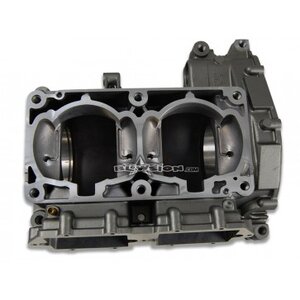I think the highest level of development in two strokes is found in dirt bikes and snowmobiles (well really two stroke gp racers, but it's hard to find pictures of those and they did lots of goofy stuff for packaging purposes), so I would be looking to those for inspiration.
Also the 66e Yamaha is on a higher level than the 62t.
There is a general theme here of pointing the reeds tangent to the top of the crankshaft and having a big clear path to the bottom of the cylinder and the transfer ports...which is basically what case porting does within the constraints of the 62t architecture.
When looking at case porting it's important to keep in mind the crankshaft is there blocking things and the bottom of the cylinder/sleeve/piston. The Polaris twin and the 66e both use a "porkchop" type crank that opens up the area from the reeds into the case during most of the rotation of the crank. Polaris takes this to kind of an extreme. I think they use a very low balance factor, there are reasons for doing that having to do with the belt drive on the snowmobile, and weight, so it might not all be motivated by flow in the case.
If you're doing both the cases and the cylinders the thing you probably could gain from most is opening up the transfer port area as much as possible. Look at the 66e Yamaha or any of the billet watercraft cylinders and they all stretch out the transfer ports to some extend. Dasa takes it to the extreme.
View attachment 398274
Some examples:
View attachment 398271View attachment 398272View attachment 398273







